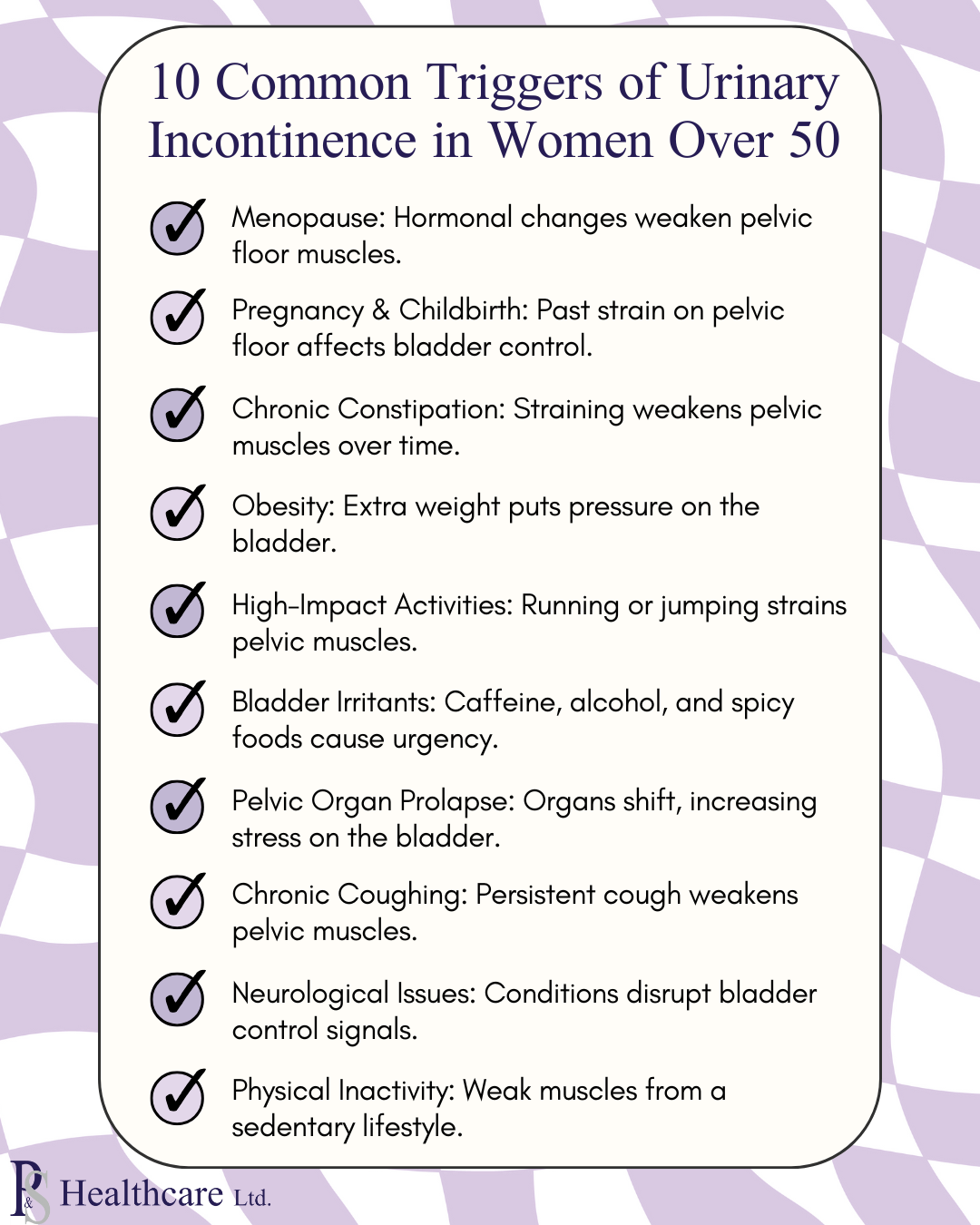10 Common Triggers of Urinary Incontinence in Women Over 50

Urinary incontinence is a common issue for women over 50, often stemming from a combination of physical changes and lifestyle factors. While this condition can be challenging, understanding its triggers is the first step towards managing it effectively. Here are 10 common causes:
Urinary incontinence is a common issue for women over 50, often stemming from a combination of physical changes and lifestyle factors. While this condition can be challenging, understanding its triggers is the first step towards managing it effectively. Here are 10 common causes:
1. Menopause
The hormonal changes that occur during menopause, particularly the decline in estrogen levels, can weaken the pelvic floor muscles and the tissues surrounding the bladder and urethra, leading to incontinence.
2. Pregnancy and Childbirth History
Even decades after giving birth, the strain placed on the pelvic floor during pregnancy and delivery can contribute to incontinence later in life. Vaginal deliveries, in particular, may increase the risk.
3. Chronic Constipation
Straining during bowel movements places consistent pressure on the pelvic floor muscles, weakening them over time and increasing the likelihood of urinary incontinence.
4. Obesity
Carrying excess weight puts additional strain on the bladder and pelvic muscles, making it harder to control urine leakage, particularly during physical activities.
5. High Impact Activities
Engaging in high-impact activities, such as running or jumping, can put stress on the pelvic floor muscles. Over time, this can weaken the muscles, increasing the risk of urinary leakage.
6. Bladder Irritants
Caffeine, alcohol, spicy foods, and carbonated drinks can irritate the bladder lining, leading to urgency and an increased risk of leakage.
7. Pelvic Organ Prolapse
In some women, the pelvic organs, such as the bladder or uterus, can shift out of place due to weakened muscles, contributing to stress or urge incontinence.
8. Chronic Coughing
Persistent coughing, often due to smoking or respiratory conditions, can strain the pelvic floor muscles and lead to leakage during coughing episodes.
9. Neurological Conditions
Conditions such as Parkinson’s disease, multiple sclerosis, or stroke can disrupt nerve signals between the brain and bladder, impairing bladder control.
10. Physical Inactivity
A sedentary lifestyle can weaken the pelvic floor muscles over time, reducing their ability to support the bladder and maintain continence.
Managing Urinary Incontinence
While these triggers can be daunting, there are many ways to manage urinary incontinence effectively. Pelvic floor exercises, dietary changes, weight management, and seeking medical advice are excellent starting points.
If you’re experiencing symptoms, remember that help is available. Consult a healthcare professional to explore treatment options tailored to your needs.
Download out useful infographic below:

More News:
- 10 Things You Should Know About Postpartum Incontinence
- 10 Common Triggers of Urinary Incontinence in Women Over 50
- 10 Tips for Night-Time Incontinence Management in Adults
- 10 Ways to Manage Incontinence While Playing Sports
- 10 Tips for Managing Faecal Incontinence in Adults
- 10 Lifestyle Changes to Manage Urinary Incontinence Symptoms
- 10 Ways to Manage Urinary Incontinence During Pregnancy
- 10 Causes of Urinary Incontinence in Men and How to Treat Them
- 10 Practical Solutions for Coping with Incontinence at Work
- 10 Myths About Menopause and Incontinence You Should Stop Believing
- 10 Foods to Avoid to Prevent Bladder Irritation and Incontinence
- 10 Effective Pelvic Floor Exercises for Urinary Incontinence
- 10 Common Causes of Bedwetting in Children and How to Address Them
- Causes of Faecal Incontinence
- Breaking the Silence: Managing Incontinence with Confidence
- Supporting Loved Ones with Incontinence: A Caregiver's Guide
- Top 10 Tips for Managing Incontinence Comfortably This Christmas
- Pregnancy and Postpartum Incontinence: Prevention and Recovery
- 10 Random Facts About Pee You Probably Didn't Know
- Diet and Bladder Health: Foods That Help and Hurt
- Helping Your Child Manage Incontinence: A Parent's Resource
- The Most Common Bladder Control Problems and How to Manage Them
- 10 Things That Can Make Incontinence Worse
- Incontinence Myths vs Facts - Dispelling Common Misconceptions
- Top 10 tips to help with bladder control during pregnancy
- 10 Effective Ways to Stop Bladder Leaks & Manage Incontinence
- P&S Washable Face Mask with ViralOff
- New Product For Men - The Slip Brief
- New Monthly Protection Briefs For Women
- New Product - The OooPS Pant for Stress Incontinence
- New Adult Inco-elite Range Launched
- EMDA WOMEN OF WORTH AWARD 2009
- New Website Launched
- New Website Under Development

